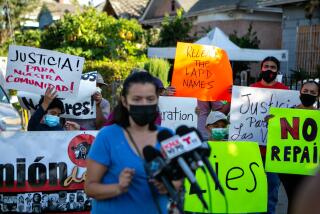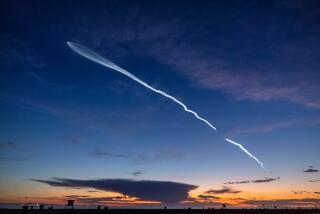Live Ammo Still a Worry in Tierrasanta Canyons
Saturday, Dec. 10, 1983, 4:05 p.m.-- Two Tierrasanta boys, Matthew Paul Smith and Corey Alden Peake, both 8 years old, are killed and Peake’s brother Carl, then 12 years old, is injured when a 37mm anti-tank shell they find in a canyon near their home explodes when they bang it against a rock.
Saturday, Dec. 17-- The Army begins a canyon sweep that will net 108 pieces of live ordnance in just three days.
January, 1984--The Navy is called in to take over sweep operations.
April 27-- At the close of a 14-week, $30,000 Navy sweep, 164 sailors and Marines, scouring about 320 of the 660 city-owned acres, have uncovered 190 pieces of ordnance, of which approximately 10% were still explosive. Navy, fire and local officials warn that more shells will continue to surface.
The problems continue, as do official efforts to do something about them.
Betty Holman, the mother of eight Tierrasanta children, was approached not long ago by her 15-year old son, Christopher, with the news that he and a friend had found what appeared to be an explosive shell while riding their dirt bikes in a canyon near their home.
“It’s a worry,” she said Friday of the continuing discovery of stray ordnance around her neighborhood, formerly the site of a military base. The shell her son found was in an area the Navy did not sweep, she said.
“It wasn’t an area they thought was dangerous,” she said, adding that fire officials said the 76-millimeter anti-personnel shell might have exploded had there been a brush fire. “I’ve told the boys to stay out of the canyons.”
Since the Navy halted its sweeps late in April, the Fire Department has been called out 30 times to pick up various pieces of ordnance, including 81mm mortar rounds, signal flares, a 75mm projectile, a 20mm projectile, .50-caliber armor-piercing rounds and a 25-pound practice bomb.
Fire Capt. Marion Nixon of the ordnance disposal unit said the Fire Department does not attempt to determine whether a shell is live or not; it turns all ordnance over to the Navy. The shells are exploded at a remote site in the desert, he said.
Nixon said the Fire Department has been called to pick up items in the area that the Navy swept last year.
“The sweeps are not going to solve the problem,” Nixon said. Searchers “only pick up what they see.”
He said metal detectors are impractical because they sense even small pieces of iron from already exploded shells.
“You can’t take a step without picking up a frag,” Nixon said.
Harold Stocking, an area resident, said he called the Fire Department in late 1984 to pick up a 90-pound, 105mm shell he found in a canyon behind his home. Stocking said he discovered the shell near the area of the Navy sweep and said he believed Navy personnel had already seen it. However, a few months later he spotted the shell again.
“It was so old, I thought the Navy looked at it and thought that it was harmless. Then I thought, well, I better call the Fire Department.” Stocking said fire and Navy officials determined the shell to be a World War I era experimental one.
Prompted by the discovery of at least 30 pieces of military ordnance in Tierrasanta since April, both state and federal officials have sought money for a continual program aimed at ridding the neighborhood canyons of the potentially deadly shells.
Assemblyman Larry Stirling (R-San Diego), in a letter to Gov. George Deukmejian, requested that the governor order the California Office of Emergency Services to reverse its recommendation that the state stay out of the matter and that the military handle the ordnance cleanup.
Stirling wrote, “As was entirely predictable, they (the U.S. military) did respond, searched the immediate area and after public attention died down . . . left. However, shells continue to be found and found in areas not remote to human habitation.”
“It’s absolutely the U.S. military’s obligation to get in there and clear (the shells) out,” Stirling said Thursday.
He added that California spends millions of dollars in toxic waste cleanups and should finance the Tierrasanta cleanup, so “certainly we can afford to clear live rounds designed for death and destruction out of the neighborhoods.”
Stirling said that if he gets no positive response from the state, he will introduce legislation in the Assembly to finance a long-term cleanup.
A spokesman for the governor said the Office of Emergency Services is reviewing Stirling’s letter and will make a recommendation to Deukmejian in a few weeks.
At the federal level, Rep. Bill Lowery (R-San Diego) has appealed to Secretary of Defense Caspar Weinberger to tap into the $314-million Environmental Restoration Fund-Defense to finance a continual cleanup program.
The Environmental Restoration Fund-Defense was created in 1983 under the leadership of Sen. Ted Stevens (R-Alaska) to clean up asbestos from Department of Defense buildings that the federal government sold to the Anchorage School District.
Although Lowery did not specify an amount, an aide to Lowery said a California National Guard study, compiled immediately after the Dec. 10, 1983, explosion, specified that $4.5 million would be needed for an effective program.
“I believe it is now the responsibility of the federal government and the Department of Defense to protect the Tierrasanta community by developing a workable, affordable and long-term solution to this danger of stray ordnance,” Lowery wrote.
Lowery also stressed the importance that weather plays in eroding the soil and exposing buried shells to curious children.
Lowery suggested that the federal money be used to expand the scope and training of the local Navy ordnance disposal teams and that the teams “regularly sweep, inspect and remove the ordnance from Tierrasanta.”
A spokesman for Lowery’s office said the congressman is pushing for a 10-year program of annual sweeps with sophisticated electronic equipment.
There has been no response to Lowery’s request from the Pentagon.
Tierrasanta, a 2,600-acre community, was built on what used to be part of Camp Elliott, a 43-square-mile Marine training facility. The camp was used as an artillery range during World War II.
After the war, the government transferred the land to the Navy. In 1961, the Navy declared 13,300 acres surplus and swapped them with L.S. Murphy, a Marin County landholder, for property that became part of the Point Reyes National Seashore. The landholder later sold the land to Christiana Co., the master developer of Tierrasanta.
The land was swept for shells in 1964 and again nine years later during Tierrasanta’s early development. In the 1973 sweep, 18 unexploded shells were discovered. Christiana Co. deeded 800 acres consisting of mostly canyons to the City of San Diego. It was on this city-owned land that the fatal explosion occurred.
More to Read
Sign up for Essential California
The most important California stories and recommendations in your inbox every morning.
You may occasionally receive promotional content from the Los Angeles Times.










